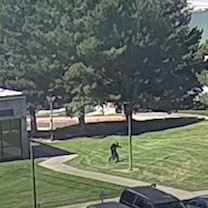Steven Spielberg celebrates 50th anniversary 'Jaws' exhibition at Academy Museum

LOS ANGELES -- Why would anyone keep a prop from the set of “Jaws?”
Steven Spielberg was musing about what it felt like while making his 1975 oceanic classic, and how little he thought any of it would matter when shooting the now-legendary opening scene of a woman night-swimming past an ocean buoy. His primary concern was keeping his job as a 26-year-old director amid unfolding disasters.
“How did anybody know to take the buoy and take it home and sit on it for 50 years?” he said.
That prop is among the first things visitors will see as they enter a 50th anniversary “Jaws” exhibit opening Sunday and running through July at the Academy Museum of Motion Pictures.
The exhibition featuring more than 200 pieces from the culture-changing blockbuster is the first full show in the four-year history of the museum that is dedicated to a single film. It comes amid a bevy of celebrations of the film's five-decade life, including a theatrical re-release last week.
Spielberg spoke to a gathering of media at the museum after touring the exhibit, which takes visitors chronologically through the film's three acts, with some relic or recreation from virtually every scene.
“I’m just so proud of the work they’ve done,” the 78-year-old said. “What they’ve put together here at this exhibition is just awesome. Every room has the minutiae of how this picture got together.”
“Clearly this is a very historic initiative for us,” museum director Amy Homma said before introducing the director and also announced the museum plans a full Spielberg retrospective in 2028.
“Jaws” has been essential to the Academy Museum, which opened in 2021 and is operated by the organization that gives out the Oscars.
The only surviving full-scale mechanical shark from the production, 25 feet in length and nicknamed “Bruce” by Spielberg after his lawyer, has permanently hung over the escalators since it opened.
Homma said Bruce has become an “unofficial mascot” that “helped to define this museum.”
The media preview was accompanied by a 68-piece orchestra playing John Williams’ score. Two of the musicians played on the original.
The exhibit includes a keyboard with instructions on how to play Williams' famously ominous two-note refrain that a generation of children learned to tap out on the piano.
Similar novelties include a dolly-zoom setup to which visitors can attach their phone and shoot their own face to recreate perhaps the film’s most famous shot, the zoom-in to star Roy Scheider’s frightened gaze on the beach in the fictional town of Amity.
There is also a small scale-model of the film’s mechanical sharks that patrons can manually operate as crew members did at the time. And a photo-friendly recreation of the galley of the Orca — the vessel that prompted Scheider to say “You're gonna need a bigger boat” — where he, Richard Dreyfuss and Robert Shaw sat, drank, sang sea-shanties and compared scars and shark tales.
But it's the real stuff from the production that really makes the show, with relics from both sides of the camera.
There's that buoy initially kept by Lynn Murphy, a marine mechanic who worked on the film who lived in Martha's Vineyard where the film was shot, before selling it to a collector in 1988.
And there is a dorsal fin prop that struck terror in beachgoers in the film and moviegoers in the theater, and a real great white shark's jaw used for reference by the filmmakers that also appeared on screen.
Film geeks can get a close look at the aquatic cameras used by cinematographer Bill Butler and his team, and a Moviola used by editor Verna Fields. And they can get a play-by-play of the processes of casting director Shari Rhodes and a team of screenwriters that included Peter Benchley, author of the novel.
Spielberg said for him the exhibition above all “proves that this motion picture industry is really truly a collaborative art form. No place for auteurs.”
He said the crew's camaraderie was the only thing that kept the production together.
Their making of the riveting film was oddly enough marked mostly by boredom — endless waits because of unfavorable conditions, unwanted ships in the background and broken down equipment that led to the shoot going 100 days over schedule.
“I just really was not ready to endure the amount of obstacles that were thrown in our path, starting with Mother Nature,” Spielberg said. “My hubris was we could take a Hollywood crew and go out 12 miles into the Atlantic Ocean and shoot an entire movie with a mechanical shark. I thought that was to go swimmingly.”
People played a lot of cards. Others tried to reckon with seasickness.
“I’ve never seen so much vomit in my life,” he said.
It would be worth it in the end.
“The film certainly cost me a pound of flesh,” he said, “but gave me a ton of career.”
ABC News







